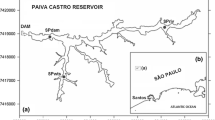Abstract
The zinc and lead concentrations were compared in several pairs of sediment cores obtained with a modified K-B corer and by Scuba diver from Coon Lake, Canada. A slow approach to and penetration of the sediments (ca. 0.1 m s-1) was employed for both coring devices. The modified K-B corer gave similar lead and zinc profiles to the diver cores. The divers observed that the K-B corer caused no disturbance of the surface sediment layers as it approached and entered the sediments. These results suggest that the K-B corer is suitable for use in lake studies requiring short, undisturbed cores from fine-grained sediments.
Similar content being viewed by others
References
Baxter, M. S., Farmer, J. G., McKinley, I. G., Swan, D. S. & Jack, W., 1981. Evidence of the unsuitability of gravity coring for collecting sediment in pollution and sedimentation rate studies. Environ. Sci. Technol. 15: 843–846.
Bertine, K. K. & Mendeck, M. F., 1978. Industrialization of New Haven, Conn., as recorded in reservoir sediments. Environ. Sci. Technol. 12: 201–207.
Birks, H. H., Whiteside, M. C., Stark, D. M. & Bright, R. C., 1976. Recent paleolimnology of three lakes in Northwestern Minnesota. Quat. Res. 6: 249–272.
Brinkhurst, R. O., Chua, K. E. & Batoosingh, E., 1969. Modification in sampling procedures as applied to studies on the bacteria and tubificid oligochaetes inhabiting aquatic sediments. J. Fish. Res. Bd Can. 26: 2581–2593.
Bruland, K. W., Koide, M., Bowser, C., Maher, L. J. & Goldberg, E. D., 1975. 210Pb and pollen geochronologies on Lake Superior sediments. Quat. Res. 5: 89–98.
Burke, J. C., 1965. A sediment coring device of 21-cm diameter with sphincter core retainer. Limnol. Oceanogr. 13: 714–718.
Craib, J. S., 1965. A sampler for taking short undisturbed marine cores. J. Cons. perm. int. Explor. Mer. 30: 34–39.
Crecelius, E. A. & Piper, D. Z., 1973. Particulate lead contamination recorded in sedimentary cores from Lake Washington, Seattle. Envir. Sci. Technol. 7: 1053–1055.
Cross, P. M., 1977. An attempt to estimate phosphorus retention in Bob Lake from iron retention and the iron: phosphorus ratio in the sediments. M.Sc. Thesis, Univ. of Toronto, Ont. 121 pp.
Edgington, D. N. & Robbins, J. A., 1976. Records of lead deposition in Lake Michigan sediments since 1800. Envir. Sci. Technol. 10: 266–274.
Eisenreich, S. J., Hollod, G. J. & Johnson, T. C., 1979. Accumulation of polychlorinated biphenyls (PCBs) in surficial Lake Superior sediments. Atmospheric deposition. Envir. Sci. Technol. 13: 569–573.
Emery, K. O. & Dietz, R. S., 1941. Gravity coring instrument and mechanics of sediment coring. Bull. geol. Soc. Am. 52: 1685–1715.
Emery, K. O. & Hulsemann, J., 1964. Shortening of sediment cores collected in open barrel gravity corers. Sedimentology 3: 144–154.
Evans, H. E., 1982. Gravity core sampling in recent lake sediments: the influence of core tube diameter on recovering short cores. M.Sc. Thesis, Trent Univ., Peterborough, Ont. 96 pp.
Galloway, J. N. & Likens, G. E., 1979. Atmospheric enhancement of metal deposition in Adirondack lake sediments. Limnol. Oceanogr. 24: 427–433.
Hamilton, A. L., Burton, W. & Flannagan, J. F., 1970. A multiple corer for sampling profundal benthos. J. Fish. Res. Bd Can. 27: 1867–1869.
Hongve, D. & Erlandsen, A., 1979. Shortening of surface sediment cores during sampling. Hydrobiologia 65: 283–287.
Jackson, M. B., 1979. Winter oxygen loss in three lakes in southern Ontario. M.Sc. Thesis, Trent Univ., Peterborough, Ont. 55 pp.
Kemp, A. L. W., Gray, C. B. J. & Mudrochova, A., 1972. Changes in C, N, P and S in the last 140 years in 3 cores from lakes Ontario, Erie and Huron. In: H. E. Allen & J. R. Kramer (eds.), Nutrients in Natural Waters. Wiley, N.Y., pp. 251–279.
Kemp, A. L. W., Saville, H. A., Gray, C. B. & Mudrochova, A., 1971. A simple corer and a method for sampling the mudwater interface. Limnol. Oceanogr. 16: 689–694.
Kemp, A. L. W., Williams, J. D. H., Thomas, R. L. & Gregory, M. L., 1978. Impact of man's activities on the chemical composition of the sediments of lakes Superior and Huron. Wat. Air Soil Pollut. 10: 381–402.
Mackereth, F. J. H., 1958. A portable core sampler for lake deposits. Limnol. Oceanogr. 3: 181–191.
Mackereth, F. J. H., 1969. A short core sampler for subaqueous deposits. Limnol. Oceanogr. 14: 145–151.
Matsumoto, E., 1975. 210Pb geochronology of sediments from Lake Shinji. Geochem. J. 9: 167–172.
Milbrink, G., 1968. A microstratification sampler for mud and water. Oikos 19: 105–110.
Osborne, P. L. & Moss, B., 1977. Paleolimnology and trends in the phosphorus and iron budgets of an old man-made lake, Barton Broad, Norfolk. Freshwat. Biol. 7: 213–233.
Patton, K. T. & Griffin, G. T., 1969. An analysis of marine corer dynamics. Mar. Technol. Soc. J. 3: 27–40.
Phleger, F. B., 1951. Ecology of Foraminifera, northwest Gulf of Mexico: 1. Foraminifera distribution. Geol. Soc. Am. Mem. 46: 1–88.
Robbins, J. A., 1980. Sediments of Southern Lake Huron: Elemental composition and accumulation rates. EPA-600/3–80080. 310 pp.
Robbins, J. A., Krezoski, J. R. & S. C. Mozley, 1977. Radioactivity in sediments of the Great Lakes: post-depositional redistribution by deposit-feeding organisms. Earth planet. Sci. Lett. 36: 325–333.
Sly, P. G., 1981. Equipment and techniques for offshore survey and site investigations. Can. geotech. J. 18: 230–249.
Sly, P. G. & Gardener, K., 1970. A vibro corer and portable tripod-winch assembly for through ice sampling. Proc. 13th Conf. Great Lakes Res. 297–307.
Smol, J. P. & Dickman, M. D., 1981. The recent histories of three Canadian Shield lakes: a paleolimnological experiment. Arch. Hydrobiol. 93: 83–108.
Webb, T. III., 1973. Pre-and postsettlement pollen from a short core, Trout Lake, North-Central Wisconsin. Wis. Acad. Sci. Arts Lett. 61: 141–148.
Williams, J. D. H. & Pashley, A. E., 1979. Lightweight corer designed for sampling very soft sediments. J. Fish. Res. Bd Can. 36: 241–246.
Wright, H. E., Cushing, E. J. & Livingstone, D. A., 1965. Coring devices for lake sediments. In: B. Kummel & D. Raup (eds.), Handbook of Paleontological Techniques. W. H. Freeman & Co., San Francisco, 494–520.
Author information
Authors and Affiliations
Rights and permissions
About this article
Cite this article
Evans, H.E., Lasenby, D.C. A comparison of lead and zinc sediment profiles from cores taken by diver and a gravity corer. Hydrobiologia 108, 165–169 (1984). https://doi.org/10.1007/BF00014876
Issue Date:
DOI: https://doi.org/10.1007/BF00014876




